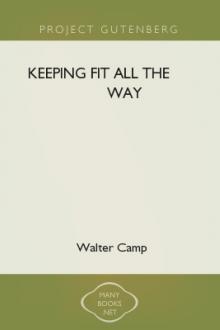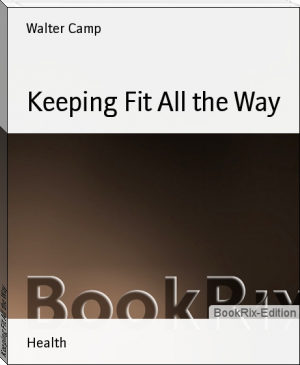Keeping Fit All the Way by Walter Camp (highly illogical behavior .TXT) 📖

- Author: Walter Camp
- Performer: 1428008233
Book online «Keeping Fit All the Way by Walter Camp (highly illogical behavior .TXT) 📖». Author Walter Camp
The movement calls for prompt control of the muscles; in fact, the expression is often used of "snapping into attention," meaning that the man comes into this position quickly and easily and with a distinct click of the heels. In the "Daily Dozen" referred to later in this book, this position is called "Hands."
This movement is taken from the position of "Attention" by raising the arms from the sides and turning the palms down; it may be varied by turning the palms up. Holding the arms in this position, at the same time turning the hands and keeping the neck straight and the chest arched, will develop all the muscles over the shoulder. (See Fig. 2.)
FIG. 2.—ARMS CROSS On the "Cross" position the arms should be straight out horizontally from the body, with the elbows locked. At the same time, resistance should be placed against the head and neck coming forward at all. These should be held in exactly the same position as at "Attention." The tendency is either to let the arms bend a little or to let them drop below the horizontal, or even to hold them slightly above the level. FIG. 2.—ARMS CROSSFrom this position "shoulder-grinding" may be practised. This is executed by keeping the arms extended, turning the whole arm in a circle in the shoulder socket, and forcing the shoulder-blades back and together as the arms go back. The circle made by the hands should be about twelve inches in diameter.
In this exercise the arms are raised to a position straight up above the head, with the hands extended. The palms may be together or facing front. (See Fig. 3.)
FIG. 3.—ARMS STRETCH FIG. 3.—ARMS STRETCH(This order is given, "Hips-Firm!")
The hands are placed on the hips, with thumbs back and fingers forward. The chest should be arched, the shoulders and elbows kept well back, and the neck pushed hard against the collar. (See Fig. 4.)
Also the hips should be kept well back and the abdomen in. This gives the same poise as the "Attention" position, but it puts more work on the shoulder muscles and so gives greater opportunity for arching the chest. In the "Daily Dozen" this position is called simply, "Hips."
FIG. 4.—HIPS FIRM FIG. 4.—HIPS FIRM(This order is given, "Neck-Firm!")
Maintaining the same position as in "Hips Firm," the hands are quickly raised and put against the back of the head (the finger-tips slightly interlaced) just where it joins the neck, exerting some pressure; at the same time the head and neck are forced well back. (See Fig. 5.)
The elbows should not be allowed to come forward, but should be kept back and the chest should be arched. This gives extra work for the muscles of the neck, as well as for those of the arms and shoulders. In the "Daily Dozen" this is called simply, "Head." (See Fig. 6.)
Fig. 6—INCORRECT POSITION OF SHOULDERS IN NECK FIRM Fig. 6—INCORRECT POSITION OF SHOULDERS IN NECK FIRMWhile maintaining an erect position, the arms are stretched out forward parallel to each other, the shoulders being kept back and the chest not cramped. If the shoulders are allowed to come forward the exercise is valueless. (See Fig. 7.)
FIG. 7.—ARMS REACH FIG. 7.—ARMS REACHIn this position the arms are bent at the elbows, with the hands partially clenched, and brought up about to the point of the shoulders. The shoulders are held back firmly and the neck is pressed against the collar, while the chest is arched (See Fig. 8). From this position the following movements are made with the hands clenched: Arms Cross (Ready-Cross)![1]
FIG. 8.—ARMS BEND FIG. 8.—ARMS BENDA good exercise in rhythmic time may be developed by going through the following round of movements: "Arms Bend, Arms Cross, Arms Bend, Arms Stretch, Arms Bend, Arms Reach, Arms Bend, Arms Down."
Assuming the position of "Neck Firm," press the hands against the back of the neck and bend body at the waist forward, at the same time keeping the head in line with the spinal column and the eyes up; then back again to the erect position. (See Fig. 6a, Chapter XI.)
This gives excellent exercise for the muscles of the neck, and, if performed slowly, some exercise for the back.
Assuming the same position of "Neck Firm," bend the body slightly at the waist. This exercise should not be carried to an extreme, especially in the case of men who have reached middle age. In the "Daily Dozen" this is called "Grasp."
Assume the position of "Attention," then, standing on the right foot and keeping the knees straight, advance the left foot forward about two feet from the ground. Hold this position while balancing on the right foot, then back to "Attention" again. (See Fig. 9.)
FIG. 9.—BALANCING FIG. 9.—BALANCINGMake the same motion, standing on the left foot. Now standing on the right foot, advance the left foot and, instead of bringing it to the ground, swing it back and extend it at the same height to the rear, still balancing on the other foot. Hold this position for a moment. After some practice this movement can be executed by standing on one foot and putting the other leg first forward and then back for several times.
This exercise gives control over the muscles of the leg and balancing powers, and increases the ability to adjust the muscles so as to maintain the equilibrium.
This position calls for the separation of the feet sideways about a foot and a half apart (Fig. 10). Now assume the "Arms Cross" attitude, and then, turning the body at the hips, bring first the right hand down to touch the floor, at the same time bending the right knee and keeping the left knee straight. Come back to the regular position again.
FIG. 10.—STRIDE, FIRST POSITION FIG. 10.—STRIDE, FIRST POSITIONNow bend the left knee, put down the left hand and touch the ground, turning the body at the hips. (See Fig. 11.)
FIG. 11.—STRIDE, FINAL POSITION FIG. 11.—STRIDE, FINAL POSITIONIn both of these movements keep the other arm extended backward. This produces a graceful exercise which is excellent work for the muscles of the body and shoulders. In the "Daily Dozen" this is called "The Weave."
Assuming the "Stride Position," advance the right foot about a foot; then, with the arms in "Cross" position once more, bend the forward knee and touch the ground with the hand, at the same time keeping the other arm extended backward.
Reverse this.
This movement is also excellent for the muscles of the body and back.
Stand sideways to the wall about two feet and a half away; now extend both arms in the "Cross" position, and then lift the foot that is farthest away from the wall and lean over until the extended fingers of the other hand touch the wall; push back into original position. Move out a little farther from the wall and repeat. Do this until the distance is as far as can comfortably be recovered by pushing the hand against the wall.
Reverse this exercise, so as to do it with the other arm.
This is an excellent workout for the shoulder muscles as well as for the forearms, and gives some exercise to the body.
Standing erect at "Attention," step to the right with the right foot about six inches, merely touching the toe to the ground, and bring the foot back to the "Attention" position.
The object of this movement is to give control of the muscles of the leg in addition to the balancing of the body. Care should be taken to keep the body absolutely motionless while the exercise is in progress. The toe is only touched to the ground and the foot is brought immediately back into position.
This movement has a quieting effect after more violent exercising. It can be done either sideways, forward, or back.
Beginning with "Marking Time!" Now raise the feet alternately from the ground, a little higher each time, until the knees come up practically to a level with the waist. Then perform this same motion on the toes and shift into a run while still holding the same position—that is, while going up and down on the toes. Men who have considerable weight around the waist-line should place their hands on the abdomen when performing this exercise.
This movement consists in turning the body at the hips while keeping the feet and legs in the original position. It may be done from almost any of the positions already outlined, and is moderate work for the muscles of the waist. Do it first with the arms in "Cross" position, turning to the right as far as possible; then back to the "Front," or original, position; then to the left as far as possible, and back to the "Front," or original, position, taking pains that the turning is executed above the hips while the legs and feet hold their original position. A more pronounced method is given in the "Daily Dozen" in "Wave" and "Weave."
Standing on both feet at "Attention," raise the heels, and hold the position for a moment; then drop the heels again. Repeat this.
Now, standing in "Stride Position," go up onto the toes again. Drop the heels and repeat.
This is an excellent exercise for the muscles of the calf.
GROUP EXERCISESHips: Same position, but hands on hips, elbows back.
Neck (or "Head"): Same position, but hands on back of neck, elbows back.
Cross: Same position, but arms extended full length out from body, palms down.
Grind: Maintaining the "Cross" position, turn palms up, and then make ten circles with hands, the diameter of the circle to be one foot (Fig. 12). In doing this keep the arms horizontally out from the body, and on the backward sweep try to make the shoulder-blades almost meet at the back. (See Fig. 4, Chapter XI.) Rest ten seconds. Deep breathing with hands on hips.
FIG. 12.—"GRIND," SHOWING HOW THE PALMS OF HANDS ARE TURNED UP IN THIS EXERCISE FIG. 12.—"GRIND," SHOWING HOW THE PALMS OF HANDS ARE TURNED UP IN THIS EXERCISEStretch: Lift arms straight up above head, palms out.
Reach: Bring arms down, extending them straight out in front. Palms in, but keep shoulders back.
Fling: Bend elbows out and bring hands in to chest, palms down. Then to "Cross," back to "Fling" again, and so on ten times. (See Fig. 13.)
FIG. 13.—FLING. CORRECT POSITION FIG. 13.—FLING. CORRECT POSITIONWave: Assume "Reach" position. Now bend the arms sharply at wrists and just let the fingers interlock. Bring the inside of elbow close to head, keeping head up. Then, by turning the body at the hips and keeping the back straight, cause the hands to make a complete circle of the diameter of a foot (





Comments (0)